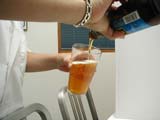
Wie steht's mit einem Bier?
 Not everyone has a beer story to tell, but I do. I was born in Germany, back when it was called West Germany and there was this huge wall. The story goes that I could sometimes be a whiny baby that needed help getting to sleep. What better way than to put a little beer in the bottle? Voila! Naptime was never a problem.
Not everyone has a beer story to tell, but I do. I was born in Germany, back when it was called West Germany and there was this huge wall. The story goes that I could sometimes be a whiny baby that needed help getting to sleep. What better way than to put a little beer in the bottle? Voila! Naptime was never a problem.
While I can enjoy a beer now and then as an adult, my tastes have matured and I tend to prefer beers that taste, well, not so much like beer.
So even though not everyone likes beer; most everyone can appreciate a good environmental neighbor, like the beer brewing industry is trying to be.
Around Earth Day this year, I received a plethora of stories about good environmental neighbors. I tucked the beer story back for the summer just because nothing refreshes like an ice cold beer on a hot summer day. According to the Beer Institute, which was established in 1986, brewers have been doing business in environmentally friendly ways before it was fashionable, just to save money (that gets me back to my internal debate about what's the difference between sustainability and conservation…).
Brewers are leading American industry in recycling, water conservation and treatment, and energy management. Here's how:
• Miller Brewing Company recycles 99.9 percent of all packaging waste and has reduced its water-to-beer ratio to less than 4:1. Also on the waterfront, many breweries recapture and treat wastewater onsite.
• Anheuser-Busch is the world’s largest operator of Bio-Energy Recovery Systems, which turns nutrients from process water into renewable biogas. The method provides up to 15 percent of the company's fuel needs at nine of its U.S. breweries. This company has its own recycling corporation. Brewers in general supply about 8 percent of their spent grain to dairy cattle farms. Byproducts of brewer's yeast are solid for application in pharmaceuticals, canned soups, and frozen entrees.
• Coors Brewing Company refines waste beer, a process byproduct, to produce 1.5 million gallons of ethanol annually. Three million gallons a year of the ethanol/gasoline blend are sold throughout Colorado’s front range.
You have to give the brewers some credit: Like cigarettes, beer is alcohol and comes with some heavy baggage. In this country today you can't be served a beer until you're 21 -- think of all the naps I would have missed.
Anyway, I'm wondering two things: Are any other manufacturing sectors coming close to implementing similar practices and can/is the Bio-Energy Recovery System be/being applied elsewhere? Anyone have any ideas?
Send your thoughts to L.K. Williams.
Posted by L.K. Williams, EPonline on Jul 11, 2008